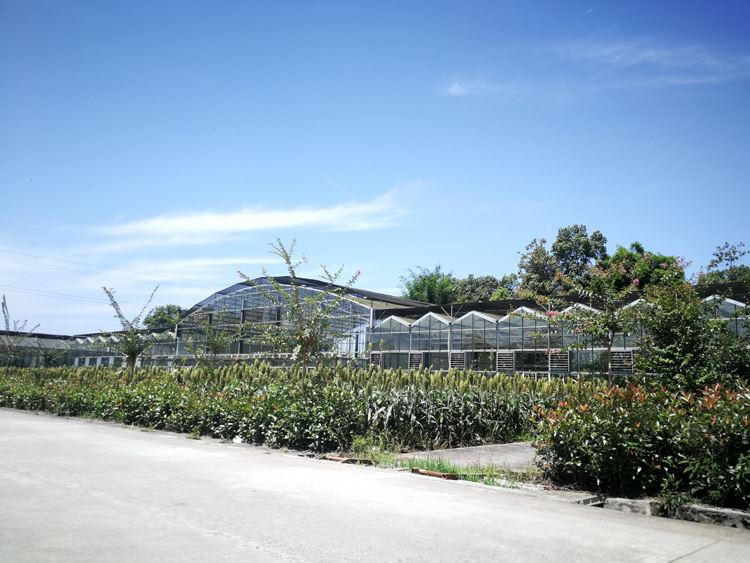What are the temperature control measures for glass greenhouses?
The temperature control in the glass greenhouse is required to maintain a set temperature suitable for the growth of crops, the temperature is evenly distributed in space, and the time change is gentle. Its control measures mainly include three aspects: heat preservation, heating and cooling.
1. Insulation
There are 3 ways to dissipate heat in the greenhouse:
One is the heat transfer through the enclosure structure (wall, transparent roof, etc.) of the covering material.
The second is the heat transfer through the ventilation of the air leakage through the gap.
The third is the ground heat transfer that exchanges heat with the soil.
These three kinds of heat transfer account for 70% to 80%, 10% to 20% and less than 10% of the total heat dissipation respectively. As a result of various heat dissipation effects, the heat preservation capacity of single-layer unheated greenhouses and plastic greenhouses is relatively small.

Even if they are well sealed, their night temperature is only 2 to 3°C higher than the outside temperature. On a windy and sunny night, sometimes there will be an inversion phenomenon where the indoor temperature is lower than the outside temperature. The specific insulation measures are as follows:
(1) Reduce the amount of ventilation;
(2) Multi-layer covering and thermal insulation; multi-layer covering methods such as small arch sheds in greenhouses or large sheds, small arch sheds in the jacket of small arch sheds, grass curtains on both sides of the large arch sheds, and movable insulation screens in the greenhouses and large arch sheds can be used. All have obvious heat preservation effect.
(3) Building the solar greenhouse into a semi-underground type or appropriately lowering the height of the room, reducing the heat dissipation area of the night protection facilities, is also conducive to increasing the indoor day and night temperature and ground temperature.
(4) High-ridge mulching cultivation is used in the greenhouse, with more organic fertilizers and less chemical fertilizers, because the re-decomposition of organic fertilizers releases a lot of heat and raises the temperature in the greenhouse, while chemical fertilizers are the opposite.
(5) When entering the autumn greenhouse, it is advisable to buckle the film as early as possible to maintain the heat accumulated in the soil after a summer; set up a cold-proof ditch at the front bottom of the greenhouse to reduce the loss of lateral heat conduction; try to use water that has been preheated in the greenhouse. Do not water on cloudy days or at night.
The heating measures mainly include:
(2) Boiler water heating heating
The radiation heating method of using liquefied petroleum gas through the combustion furnace also has a significant effect on the protection of the greenhouse from low-temperature frost damage.
3. Cool down
The simple way to cool the greenhouse is ventilation, but when the temperature is too high and natural ventilation cannot meet the requirements of crop growth, artificial cooling must be performed.
1. Shading and cooling method.
When shading 20% to 30%, the room temperature can be reduced by 4 to 6°C accordingly. A shading screen is placed about 40 cm away from the roof of the greenhouse, which is very effective for cooling the greenhouse.
The texture of the shading curtain is as small as the temperature emissivity, the better. Considering the weather resistance of plastic products, generally plastic shade nets are made of black or dark green, and some are made of silver gray.
The white non-woven fabric insulation curtain used in the greenhouse (the light transmittance is about 70%) can also be used as a shading curtain, and the temperature can be reduced by 2 to 3 ℃.
2. The roof running water cooling method.
The flowing water layer can absorb about 8% of the solar radiation projected on the roof, and can cool the roof by absorbing heat with water, and the room temperature can be lowered by 3 to 4°C. When adopting this method, it is necessary to consider the installation cost and the problem of removing scale pollution on the surface of the shed. Areas with hard water need to soften the water before use.
3. Spray cooling method.
The air is first cooled by the evaporative cooling of water and then sent into the room to achieve the purpose of cooling.
(1) The fine mist cooling method. Spray floating fine mist with a diameter of less than 0.05 mm at high places in the room, and use forced ventilation airflow to evaporate the fine mist to cool the whole room. When the spray is appropriate, the room can be evenly cooled.
(2) Roof spray method. The whole roof is continuously sprayed and humidified to make the cooled air under the roof convection downwards.
4. Forced ventilation.
Large-scale solar greenhouses require forced ventilation to cool down due to their large volume.







